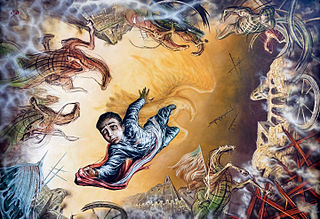Niños Héroes
The Niños Héroes (NEE-nyose AIR-o-ace, "Baby Heroes") were six Mexican teenage military cadets who died in 1847 defending Chapultepec Castle from U.S. forces. Their story illustrates three tenets of Mexican culture:
- Military bravery,
- Telling preposterous tales to keep the population calm, and
- Feigning obsequy then quietly disobeying orders.
History
Chapultepec Castle was the Mexican Army's military academy, defended by crack teenage and pre-teen troops under the command of Nicolás Bravo and General José Mariano Monterde. It was like a Justin Bieber concert with live ammo.
U.S. General Winfield Scott stormed the castle in 1847, shouting "Make America Great Again" (here meaning Latin America), and the two forces fought for about two hours, the time it took General Bravo to realize that he was outmanned and outgunned and give his historic Grito de Guerra, it went: Vámonos. However, six cadets refused to fall back and fought to the death. According to legend, the last of the six, Juan Escutia, having obscenely more bravery than common sense, leapt from Chapultepec Castle wrapped in the Mexican flag to keep it from being captured, at least until the enemy troops scoured the countryside to loot the corpses.
Revisionism
An obelisk (pictured) was erected in 1881 to commemorate the Battle of Chapultepec.
One hundred years after the fact, as hundreds of government stores selling price-controlled tortillas again ran out of product, interest in the battle spontaneously surged. A mass grave was found on the southern hillside of Chapultepec Hill. Six bodies were officially identified as belonging to the Niños Héroes, exhumed, and placed in urns well before forensic scientists reached the scene to do actual analysis of the claim. A monument was inaugurated with an honor guard from the several military academies of the Americas. So that's that.
Later the same year, U.S. President Harry S. Truman interrupted his state visit to Mexico to place a wreath at the obelisk and stood for an appropriate period of apparent silent reverence, possible brain-freeze, or vain attempt to work through the Spanish inscription. Asked by appropriately briefed American reporters why he had gone to the monument, the notoriously plain-spoken Truman said, "The hosts and my handlers told me to go there."
The claim that the cadavers are the true Niños Héroes is defended against deniers by the Mexican press and by anonymous wiki editors around the world operating Mexican-government computers during work "breaks."
Biographies
Mexicans revere the individual Niños Héroes and study their biographies in grade school. The biographies have the common feature of enlistment at an absurdly young age, into an army that was in full retreat and as casual about checking identity papers as modern Mexico is regarding the octane of gasoline and the proper registration of automobiles. Also, of promotion to a high officer rank after a matter of days in the service.
- Juan de la Barrera was born in 1828 and enlisted at the age of 12. During the Chapultepec battle, he was 19, the oldest of the six, and not technically a niño (baby) at all. In the Academy, he taught engineering, as opposed to, say, military discipline or strategy. He died defending a gun battery at the entrance to the park; the electric gun itself was never found.
- Juan Escutia was born between 1828 and 1832[1] in Tepic. Records show he was admitted to the Academy as a cadet on 8 September 1847 — five days before the fateful battle — but his other papers were lost, including the papers that would show how he suddenly became a lieutenant, as he is always portrayed. It was he who wrapped himself in the flag more tightly than Donald Trump does metaphorically in his, and jumped from the roof to keep the flag out of enemy hands for a few minutes.
- Francisco Márquez was born in 1834 in Guadalajara. He was the youngest of the six (13 years). A note in his personnel record says his body was found on the east flank of the hill, alongside that of Juan Escutia. It does not attract controversy that the note is written in metallic gel pen.
- Agustín Melgar was born between 1828 and 1832[1] in Chihuahua. A note in his personnel record (this one typeset in Microsoft Word) says he found himself alone and tried to stop the enemy on the north side of the castle. Crucially, the enemy did not find itself alone. He shot and killed one, before hiding behind a bed. Grievously wounded, he was placed on a table. Equally crucially, this was not an operating table.
- Fernando Montes de Oca was born between 1828 and 1832[1] in Azcapotzalco. He had applied to the Academy on 24 January 1847, and was accepted based specifically on his request to be part of a lethal and futile battle while the obedient members of his company were retreating.
- Vicente Suárez was born in 1833 in Puebla, Puebla, the son of Mary Hartman, Mary Hartman. A note in his record reads: "He ordered the attackers to stop, shot one, and stabbed another with his bayonet. He was killed in hand-to-hand combat because his youthfulness made the attackers hesitate, until they recovered from a fit of laughter and he attacked them."
Legacy
The Niños Héroes are commemorated in the names of Mexican cities, neighborhoods, and streets somewhat more than even revolutionary heroes and Soviet commissars.
The 5000-pez banknote commemorated the battle. The cadets are shown and named on the front of the banknote, and the castle is on the reverse. Starting in 1993, the now-worthless banknote was retired in favor of equally worthless coins that omitted the zeroes and were more likely to be spent.
Notes
See also
| Featured version: 21 December 2019 | |
| This article has been featured on the main page. — You can vote for or nominate your favourite articles at Uncyclopedia:VFH. | |





